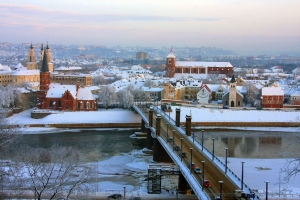Quick Facts:
Official name: Republic of Lithuania
Capital: Vilnius
Area: 65,300 sq. km
Population: ~ 3 million
Government: Parliamentary Republic
Official Language: Lithuanian
History
The first Baltic tribes settled on what is now known as Lithuanian territory in the 7th-2nd centuries BC. Lithuania was mentioned for the first time in Qedlinburg Annals in 1009. The Lithuanian State was formed in the early 13th century when the Grand Duchy of Lithuania was established by the Duke Mindaugas who was crowned the first King of Lithuania in 1253. By the 14th century Lithuania developed into one of the most powerful states in Eastern Europe. For the next two centuries the newly established state had been invaded by the Teutonic Knights, though Lithuania was not conquered. In the 14th and 15th centuries during the rule of the Grand Duke Vytautas the Great, Lithuania was one of the largest states in Europe, extending from the Baltic Sea to the Black Sea. At the same time it was the last country in Europe to accept Christianity. Lithuania progressively entered European culture.



